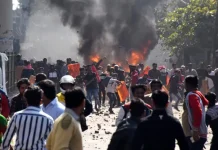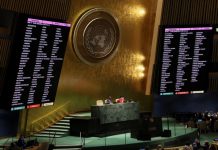India’s hospitals were packed with coronavirus patients, relatives of the sick scrambled to find supplies of oxygen, and nearly full crematoriums worked feverishly to deal with the dead.
Yet, despite those clear signs of an overwhelming health crisis, Prime Minister Narendra Modi pressed ahead with a densely packed campaign rally.
“I have never seen such a huge crowd before!” he roared to his supporters in West Bengal state on April 17, before key local elections. “Wherever I can see, I can only see people. I can see nothing else.”
As another deadly wave of COVID-19 infections was swamping India, Modi’s government refused to cancel a Hindu festival attended by millions. Cricket matches, attended by tens of thousands, carried on, too.
The catastrophic surge has led to criticism at home.
The 70-year-old, whose image as a technocrat brought him deep approval from a middle class weary of corruption and bureaucratic dysfunction, has been accused of stifling dissent and choosing politics over public health.
The government is facing a lot of criticism from courts around the country.
The Delhi High Court slammed the government for lack of facilities, including oxygen, as people continue to die of coronavirus.
Modi was also called a “super-spreader” by the vice president of the Indian Medical Association, Dr Navjot Dahiya.
With deaths mounting and a touted vaccine rollout faltering badly, Modi has pushed much of the responsibility for fighting the virus onto poorly equipped and unprepared state governments and even onto patients themselves, critics say.
“It is a crime against humanity,” author and activist Arundhati Roy said of Modi’s handling of the virus.
“Foreign governments are rushing to help. But as long as decision-making remains with Modi, who has shown himself to be incapable of working with experts or looking beyond securing narrow political gain, it will be like pouring aid into a sieve.”
When the official COVID-19 death toll crossed 200,000 – a number experts say is a severe undercount – Modi was silent.
His government says it is on a “war footing,” ramping up hospital capacity, supplies of oxygen and drugs.
When the coronavirus hit, Vaishnav said Modi took an approach different from former US President Donald Trump and current Brazilian President Jair Bolsonaro.
“He never called the virus a hoax. He took it seriously. He encouraged mask-wearing, social distancing. He encouraged the sorts of things health authorities everywhere have been calling for,” he added.
A strict nationwide lockdown last year, imposed on four hours’ notice, stranded tens of millions of migrant workers who were left jobless and fled to villages with many dying along the way. But experts say the decision helped contain the virus and bought time for the government.
Cases rose when the country started reopening in June 2020, and the government developed emergency infrastructure plans. When the wave receded and reported cases plummeted over the winter, many officials saw it as a triumph.
States dismantled makeshift hospitals and delayed adding ICU beds and ventilators.
The government had sought to create 162 oxygen plants earlier, but has only built 38. It says 105 more will be built this month.
The fragile healthcare system was not upgraded enough, said Gautam Menon, a science professor at Ashoka University, “and with the current surge, we are seeing precisely the consequences of not doing this”.
When cases ebbed in January, Modi crowed about India’s success, telling the World Economic Forum that the country “has saved humanity from a big disaster by containing corona effectively”.
His ruling Bharatiya Janata Party (BJP) hailed his “visionary leadership,” making India a “proud and victorious nation in the fight against COVID”.
In mid-March, tens of thousands attended cricket matches against England at the Narendra Modi stadium in Gujarat, an event that swelled national pride even amid warnings that infections were climbing.
By contrast, in March 2020, his government blamed a Muslim gathering of 3,000 for an initial spike in infections in a move that triggered violence and boycotts, even as courts dismissed the accusations.
Critics have blasted the BJP for holding election rallies packed with tens of thousands of unmasked supporters, particularly in West Bengal. Other parties also campaigned to large crowds.
Bowing to criticism, Modi began appearing over video instead of in-person but the crowds remained, though his party was defeated in the state.
TWITTER EPISODE: Meanwhile, to circumvent criticism, the government ordered Twitter to remove posts criticising his pandemic response.
In BJP-run Uttar Pradesh, authorities recently charged a man over a tweet pleading for oxygen for his dying grandfather, accusing him of “circulating a rumour,” as top officials deny widespread oxygen shortages.
“To blame social media or users for either critiquing or begging for help is just – I mean, what are their priorities? To help people or silence criticism?” said digital rights activist Nikhil Pahwa.
The level of urban and middle-class anger at Modi is unprecedented, political analyst Vaishnav said, although it is blunted by supporters who believe he can do no wrong.
“He shouldn’t be expected to solve all problems by himself. The government machinery which existed before him, full of corruption, is to blame,” said Sunil Saini, a driver in New Delhi. “My vote will go to Modi the next time too.”
The virus surge has sparked assistance from overseas, a reversal of India’s earlier success at “vaccine diplomacy” when it exported 64 million doses. But there is also controversy over delivery of the foreign aid.
There is an investigation in local media that showed that much of the international aid “was sitting in the airport in Delhi and at least six states including Delhi haven’t received any aid”.
Since then, some of that aid is being distributed but the problem is the needs are just so very great.
Some also say Modi’s flagship self-sufficiency campaign, known as “Make in India,” is being undermined.
“India has long sought to project itself as a strong nation that need not be dependent on any other. Its immediate need for international assistance flies in the face of that image,” said Michael Kugelman of the Asia Program at the Washington-based Wilson Center.
Some Modi supporters are lashing out. When BJP legislator Kesar Singh Gangwar died of the virus in Uttar Pradesh state, his son said Modi’s office didn’t help.
“What kind of government is this? What kind of PM is Modi?” said Vishal Gangwar. “If he cannot provide treatment to a lawmaker of his own party, what is happening to a common man is anybody’s guess.”









